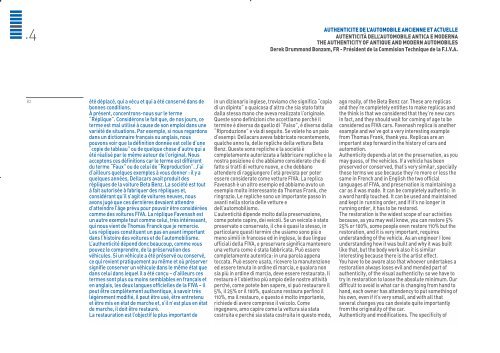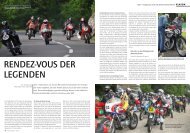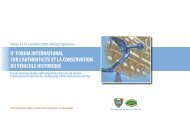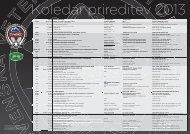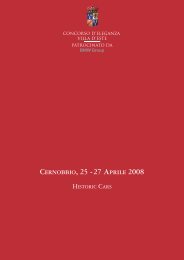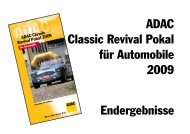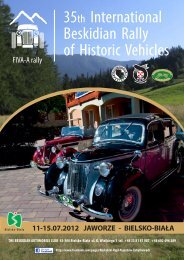FORUM INTERNATIONAL SUR L'AUTHENTICITE DU VEHICULE HISTORIQUE ...
FORUM INTERNATIONAL SUR L'AUTHENTICITE DU VEHICULE HISTORIQUE ...
FORUM INTERNATIONAL SUR L'AUTHENTICITE DU VEHICULE HISTORIQUE ...
You also want an ePaper? Increase the reach of your titles
YUMPU automatically turns print PDFs into web optimized ePapers that Google loves.
.4<br />
82<br />
été déplacé, qui a vécu et qui a été conservé dans de<br />
bonnes conditions.<br />
À présent, concentrons-nous sur le terme<br />
“Réplique”. Considérons le fait que, de nos jours, ce<br />
terme est mal utilisé à cause de son emploi dans une<br />
variété de situations. Par exemple, si nous regardons<br />
dans un dictionnaire français ou anglais, nous<br />
pouvons voir que la définition donnée est celle d’une<br />
“copie de tableau” ou de quelque chose d’autre qui a<br />
été réalisé par le même auteur de l’original. Nous<br />
acceptons ces définitions car le terme est différent<br />
du terme “Faux” ou de celui de “Reproduction”. J’ai<br />
d’ailleurs quelques exemples à vous donner : il y a<br />
quelques années, Dellacars avait produit des<br />
répliques de la voiture Beta Benz. La société est tout<br />
à fait autorisée à fabriquer des répliques et,<br />
considérant qu’il s’agit de voitures neuves, nous<br />
avons jugé que ces dernières devaient attendre<br />
d’atteindre l’âge prévu pour pouvoir être considérées<br />
comme des voitures FIVA. La réplique Favenash est<br />
un autre exemple tout comme celui, très intéressant,<br />
qui nous vient de Thomas Franck que je remercie.<br />
Les répliques constituent un pas en avant important<br />
dans l’histoire des voitures et de l’automobilisme.<br />
L’authenticité dépend donc beaucoup, comme vous<br />
pouvez le comprendre, de la préservation des<br />
véhicules. Si un véhicule a été préservé ou conservé,<br />
ce qui revient pratiquement au même et où préserver<br />
signifie conserver un véhicule dans le même état que<br />
dans celui dans lequel il a été conçu – d’ailleurs ces<br />
termes sont plus ou moins semblables en français et<br />
en anglais, les deux langues officielles de la FIVA – il<br />
peut être complètement authentique, à savoir très<br />
légèrement modifié, il peut être usé, être entretenu<br />
et être mis en état de marche et, s’il n’est plus en état<br />
de marche, il doit être restauré.<br />
La restauration est l’objectif le plus important de<br />
AUTHENTICITE DE L’AUTOMOBILE ANCIENNE ET ACTUELLE<br />
AUTENTICITÀ DELL’AUTOMOBILE ANTICA E MODERNA<br />
THE AUTHENTICITY OF ANTIQUE AND MODERN AUTOMOBILES<br />
Derek Drummond Bonzom, FR - Président de la Commision Technique de la F.I.V.A.<br />
in un dizionario inglese, troviamo che significa “copia<br />
di un dipinto” o qualcosa d’altro che sia stato fatto<br />
dalla stessa mano che aveva realizzato l’originale.<br />
Queste sono definizioni che accettiamo perché il<br />
termine è diverso da quello di “Falso”, è diverso dalla<br />
“Riproduzione” e via di seguito. Se volete ho un paio<br />
d’esempi: Dellacars aveva fabbricato recentemente,<br />
qualche anno fa, delle repliche della vettura Beta<br />
Benz. Queste sono repliche e la società è<br />
completamente autorizzata a fabbricare repliche e la<br />
nostra posizione è che abbiamo considerato che di<br />
fatto si tratti di vetture nuove, e che debbano<br />
attendere di raggiungere l’età prevista per poter<br />
essere considerate come vetture FIVA. La replica<br />
Favenash è un altro esempio ed abbiamo avuto un<br />
esempio molto interessante da Thomas Frank, che<br />
ringrazio. Le repliche sono un importante passo in<br />
avanti nella storia delle vetture e<br />
dell’automobilismo.<br />
L’autenticità dipende molto dalla preservazione,<br />
come potete capire, dei veicoli. Se un veicolo è stato<br />
preservato o conservato, il che è quasi lo stesso, in<br />
particolare questi termini che usiamo sono più o<br />
meno simili in francese ed in inglese, le due lingue<br />
ufficiali della FIVA, e preservare significa mantenere<br />
una vettura come è stata fabbricata. Può essere<br />
completamente autentica: in una parola appena<br />
toccata. Può essere usata, ricevere la manutenzione<br />
ed essere tenuta in ordine di marcia, e qualora non<br />
sia più in ordine di marcia, deve essere restaurata. Il<br />
restauro è l’obiettivo più ampio delle nostre attività<br />
perché, come potete ben sapere, si può restaurare il<br />
5%, il 25% or il 100%, qualcuno restaura perfino il<br />
110%, ma il restauro, e questo è molto importante,<br />
richiede di avere compreso il veicolo. Come<br />
ingegnere, amo capire come la vettura sia stata<br />
costruita e perché sia stata costruita in questo modo,<br />
ago really, of the Beta Benz car. These are replicas<br />
and they’re completely entitles to make replicas and<br />
the think is that we considered that they’re new cars<br />
in fact, and they should wait for coming of age to be<br />
considered as FIVA cars. Favenash replica is another<br />
example and we’ve got a very interesting example<br />
from Thomas Frank, thank you. Replicas are an<br />
important step forward in the history of cars and<br />
automotion.<br />
Authenticity depends a lot on the preservation, as you<br />
may guess, of the vehicles. If a vehicle has been<br />
preserved or conserved, that’s very similar, specially<br />
those terms we use because they’re more or less the<br />
same in French and in English the two official<br />
languages of FIVA, and preservation is maintaining a<br />
car as it was made. It can be completely authentic: in<br />
a word hardly touched. It can be used and maintained<br />
and kept in running order, and if it’s no longer in<br />
running order, it has to be restored.<br />
The restoration is the widest scope of our activities<br />
because, as you may well know, you can restore 5%<br />
25% or 100%, some people even restore 110% but the<br />
restoration, and it is very important, requires<br />
understanding of the vehicle. As an engineer I love<br />
understanding how it was built and why it was built<br />
like that, but the body work also it is similar<br />
interesting because there is the artist effect.<br />
You have to be aware also that whoever undertakes a<br />
restoration always loses evil and mended part of<br />
authenticity, of the visual authenticity: so we have to<br />
try in restoration to loose the absolute minimum. Our<br />
difficult to avoid is what car is changing from hand to<br />
hand, each owner has attendency to put something of<br />
his own, even if it’s very small, and with all that<br />
several changes you can deviate quite importantly<br />
from the originality of the car.<br />
Authenticity and modifications. The specificity of


